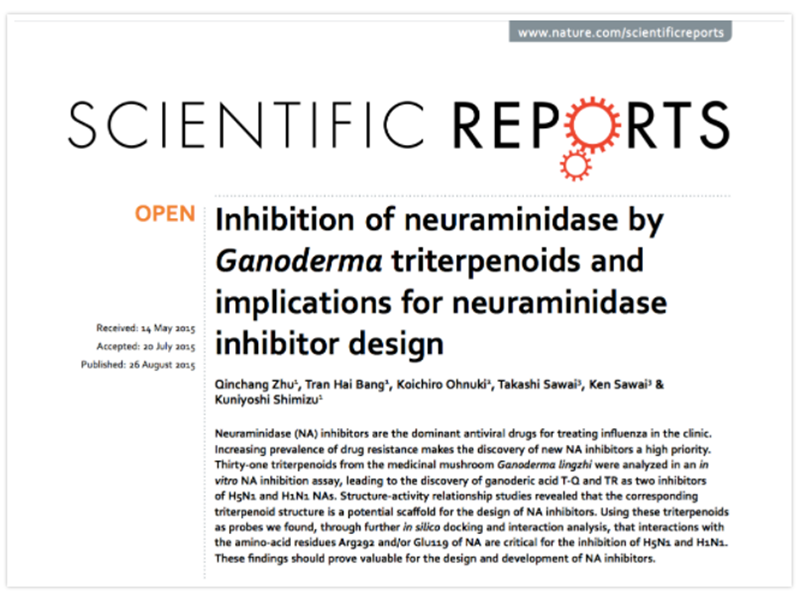August 26, 2015 / 규슈대학 / 과학 보고서
문자/우 팅야오

시미즈 구니요시 연구팀, 일본 규슈대학교 농업과학연구소 부교수, 그것을 확인했다 31 영지의 자실체에서 분리된 트리테르페노이드는 5가지 인플루엔자 A 바이러스의 뉴라미니다제를 다양한 정도로 억제합니다., 그 중에는 항인플루엔자 약물로 개발하기에 적합한 두 가지 트리테르페노이드가 있습니다.. 이번 연구 결과는 네이처(Nature) 출판그룹 산하 사이언티픽 리포트(Scientific Reports) 8월 말 게재됐다. 2015.
뉴라미니다제는 A형 인플루엔자 바이러스 표면에 튀어나온 두 가지 단백질 중 하나입니다.. 각 인플루엔자 바이러스에는 약 100개의 이러한 프로테아제가 있습니다.. 바이러스가 세포에 침입하여 세포 내 물질을 사용하여 새로운 바이러스 입자를 복제하는 경우, 새로운 바이러스 입자가 세포에서 떨어져 나와 다른 세포를 추가로 감염시키려면 뉴라미니다아제가 필요합니다.. 그러므로, 뉴라미니다제가 활성을 잃을 때, 새로운 바이러스는 세포 안에 갇혀서 탈출할 수 없습니다., 호스트에 대한 위협이 줄어들 것입니다., 그리고 질병은 통제될 수 있다. 일반적으로 사용되는 오셀타미비르 (타미플루) 임상에서는 이 원리를 이용하여 바이러스의 확산과 확산을 막는 것입니다..
시미즈 구니요시의 연구에 따르면, 농도에서 200 μM, 이 Ganoderma triterpenoids는 H1N1의 활동을 억제했습니다., H5N1, H7N9 및 2개의 저항성 돌연변이 균주 NA (H1N1, N295S) 그리고 NA (H3N2, E119V) 다양한 정도로. 전체적으로, N1형 뉴라미니다제 억제효과 (특히 H5N1) 최고다, H7N9의 뉴라미니다제 저해 효과는 최악이다.. 이들 트리테르페노이드 중에서, 가노데르산 TQ와 가노데르산 TR은 가장 높은 억제 수준을 보였습니다., 이 두 화합물의 효과는 다음과 같습니다. 55.4% 에게 96.5% 다양한 NA 하위 유형에 대한 억제.
이들 트리테르페노이드의 구조-활성 관계에 대한 추가 분석을 통해 트리테르페노이드가, N1 뉴라미니다제에 대한 더 나은 억제 효과가 있는 것, 두 개의 이중 결합을 가진 "사환식 트리테르페노이드"의 주요 구조를 가지고 있습니다., 카르복실기로서의 가지, R5 부위에 산소 함유 그룹이 있습니다.” (아래 그림의 백본 A). 주요 구조가 다른 두 개라면 (아래 그림의 백본 B와 C), 효과는 별로일 것이다.

(출처/과학 담당자. 2015 8월 26;5:13194.)
In silico 도킹은 ganoderic 산의 상호 작용을 시뮬레이션하는 데 사용됩니다. (T-Q 및 TR) 및 뉴라미니다제 (H1N1 및 H5N1). 결과적으로, 가노데르산과 타미플루 모두 뉴라미니다제의 활성 영역에 직접 결합할 수 있는 것으로 밝혀졌습니다.. 이 활성 영역은 여러 아미노산 잔기로 구성됩니다.. Ganoderma 산 TQ 및 TR은 두 개의 아미노산 잔기 Arg292 및 Glu119에 결합합니다.. 타미플루에는 또 다른 옵션이 있지만 뉴라미니다제를 무효화할 수도 있습니다..
인플루엔자 바이러스의 다른 단백질을 억제하는 것과 비교 (M2 단백질과 같은, 바이러스가 숙주 세포에 결합하는 순간 바이러스 껍질을 열고 바이러스 유전자를 세포로 보냅니다.), 뉴라미니다제 억제제는 현재 효과적이고 저항성이 낮은 인플루엔자 치료제로 인식되고 있습니다.. 그러므로, 연구자들은 ganoderic 산 T-Q와 TR을 믿습니다, 타미플루의 메커니즘과 유사하지만 동일하지는 않습니다., 차세대 항인플루엔자 약물 또는 디자인 참고자료로 활용될 수 있는 기회를 갖습니다..
하지만, 해당 의약품이 항인플루엔자 치료제로 사용되기 위해서는 전제조건이 있다., 즉, 약물은 바이러스에 감염된 세포에 해를 끼치지 않으면서 바이러스의 번식을 효과적으로 억제해야 합니다.. 하지만, 살아있는 바이러스에 감염된 세포와 유방암 세포주를 대상으로 한 실험에서 (MCF-7), 연구자들이 이 두 종류의 가노데르산을 단독으로 사용했을 때,, 그들은 높은 세포 독성에 대해 의구심을 가지고 있었습니다, 하지만 그들은 또 다른 종류의 Ganoderma triterpenoid도 발견했습니다., 가노데롤 B, H5N1에 대한 억제 효과가 있습니다 (하지만 억제효과가 약하다), 그러나 세포독성은 아니다. 그러므로, 연구자들은 뉴라미니다제 활성 억제를 유지하면서 화학 구조의 변형을 통해 가노데르산 T-Q 및 TR의 안전성을 향상시키는 방법을 신중하게 고려해야 한다고 믿습니다..
[원천] 주 Q, 외. Ganoderma triterpenoids에 의한 뉴라미니다제 억제 및 뉴라미니다제 억제제 설계에 대한 시사점. 과학 담당자. 2015 8월 26;5:13194. 도이: 10.1038/srep13194.
끝
저자 소개 / 씨. 우팅야오
Wu Tingyao는 이후 직접 Ganoderma 정보를 보고해 왔습니다. 1999. 그녀는 다음의 저자입니다. Ganoderma로 치유 (4월 인민의학출판사에 게재 2017).
★ 이 글은 저자의 단독 승인 하에 게재되었습니다..
★ 위 작품은 복제할 수 없습니다, 저작자의 허락 없이 발췌하거나 다른 방법으로 사용한 경우.
★ 위 사항을 위반한 경우, 저자는 관련 법적 책임을 추구할 것입니다.
★ 이 기사의 원문은 Wu Tingyao가 중국어로 작성하고 Alfred Liu가 영어로 번역했습니다.. 번역 내용에 차이가 있는 경우 (영어) 그리고 원본 (중국인), 원래 중국어가 우선합니다. 독자들이 궁금한 점이 있으면, 원작자에게 연락주세요, 양. 우팅야오.



